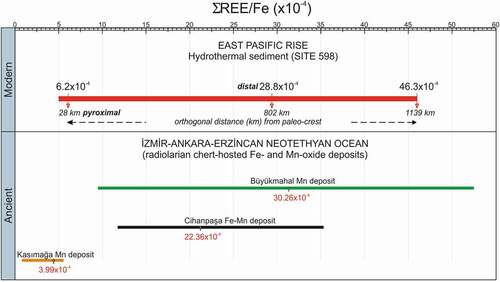Figures & data
Figure 1. Simplified geological map (modified after 1/500.000 Geological Map of TurkeyMTA, Citation2002) of the northern part of Central Anatolia. The black rectangle indicates the study area. The strike-slip faults and their names are from Yolsal-Çevikbilen et al. (Citation2012). Inset map showing main suture zones and ophiolitic complexes is from Şengör and Yılmaz (Citation1981), Okay and Tüysüz (Citation1999)
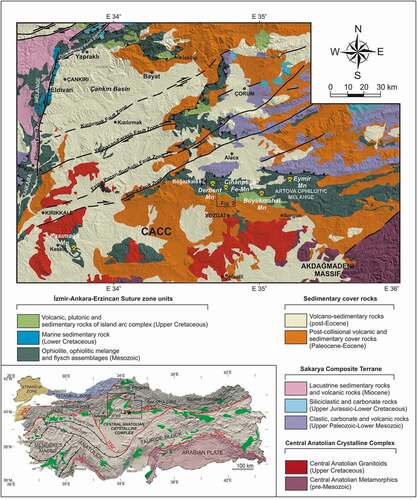
Figure 2. Geological map and cross-section of the Cihanpaşa region and its surroundings (modified after from Akçay et al., Citation2007) and cross-section showing sampling position between Otluk and Eyerci Hill (Cihanpaşa, Yozgat)
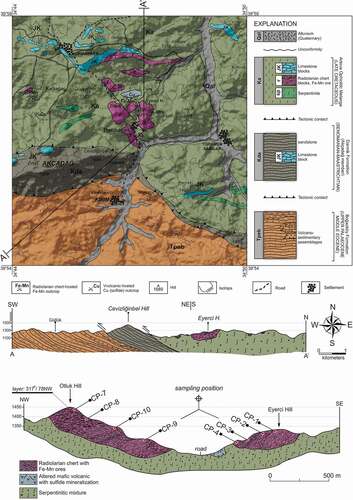
Figure 3. Field photographs of host rocks and Fe-Mn-oxide mineralisation in the Cihanpaşa region (Yozgat district, central Turkey) a thin-bedded ribbon chert layers exposed in the southern part of the studied area, b radiolarian chert layers with Fe-Mn ore, c slightly folded radiolarian chert layers and Fe-Mn ore, d sharp contact between radiolarian chert and Fe-Mn ore, e, f Altered mafic volcanics including sulphide mineralisation dispersed within the Artova mélange
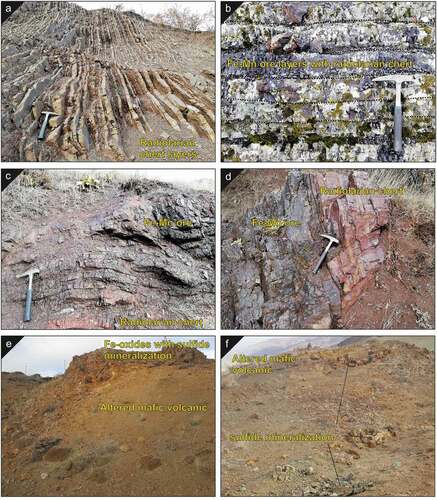
Figure 4. Photomicrographs of thin- and polished-sections. a radiolarian-rich host rock and Fe-Mn ore. All radiolarians are recrystallised to quartz, b Reddish-brownish slightly bioturbated radiolarite and quartz veinlets, c radiolarian test filled with quartz in the inner parts, d sharp contact between radiolarian chert and Fe-Mn ore, e Some radiolarians filled by quartz, f-g Fe-Mn ore consisting of haematite (hem), pyrolusite (pst), braunite (brt) and quartz (qtz) within the host rock
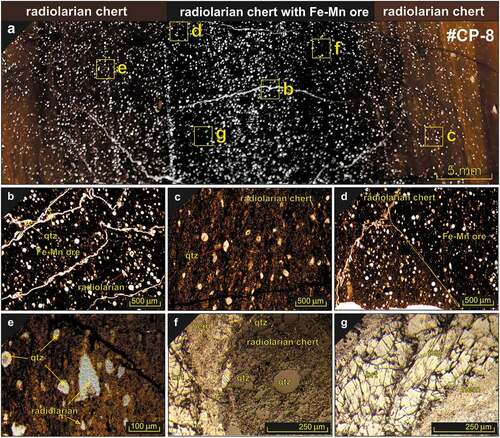
Table 1. Major, minor, and rare-earth element compositions of the Cihanpaşa Fe-Mn ores (central Turkey)
Figure 5. Element composition of Cihanpaşa Fe-Mn mineralisation a Distribution of major elements in each sample b Distribution of trace elements in each sample c Cluster analysis of major and trace elements in all samples
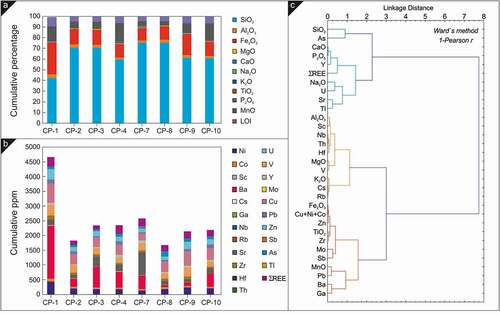
Figure 6. A PAAS (Post-Archaean Australian shale)-normalised REE patterns (normalised after McLennan, Citation1989). High- and low-temperature hydrothermal fluids, hydrogenetic Fe-Mn crust and nodules, diagenetic Fe-Mn nodule are adapted from Bau and Dulski (Citation1999), b CeSN/CeSN* versus PrSN/PrSN* discrimination diagram for Ce and Pr anomalies (Bau & Dulski, Citation1996). Note that all analysed samples of the Cihanpaşa Fe-Mn ores display true negative Ce anomalies, indicative of oxic conditions. Fields for modern deep and shallow oxic seawater from Alibo and Nozaki (Citation1999) and Nothdurft et al. (Citation2004), respectively

Figure 7. Bivariate and ternary diagrams discriminating the hydrothermal components of the Cihanpaşa region. a SiO2 vs. Al2O3 discrimination diagram indicating the hydrothermal affinity of the studied Fe-Mn samples (Bonatti et al., Citation1972; Toth, Citation1980). b Co+Ni (wt%) vs. As+Cu+Mo+Pb+V+ Zn (wt%) plot showing supergene and hydrothermal Mn-oxides (Nicholson, Citation1992). c (Co + Ni + Cu)x10-Fe-Mn ternary diagram (Bonatti et al., Citation1972). d 15*(Cu+Ni)-100*(Zr+Ce+Y)-(Mn+Fe)/4 ternary diagram (Josso et al., Citation2017). e (CeSN/CeSN*) vs Nd (ppm) and f CeSN/CeSN* vs YSN/HoSN diagrams illustrating discrimination between different genetic types of Fe-Mn deposits (Bau et al., Citation2014)
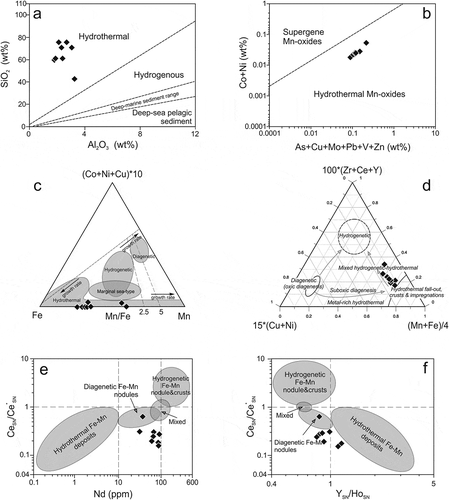
Figure 8. a Y/Ho values of the Cihanpaşa Fe-Mn, Kula Mn (Kılıç et al., Citation2018), Kasımağa Mn (Koç et al., Citation2000), Büyükmahal Fe-Mn (Öksüz & Okuyucu, Citation2014) deposits from Turkey and some materials of the Earth (Bau & Dulski, Citation1999; Bolhar & Kranendonk, Citation2007; Nozaki et al., Citation1999) b Diagram illustrating strong positive correlation between Cu+Co+Ni (ppm) and Fe2O3 (wt%) c Zr vs. Y/Ho diagram for the Fe-Mn ores from the Cihanpaşa region (central Turkey) (R shows the correlation coefficient between Zr and Y/Ho) c Strong correlation Fe2O3 and Cu+Co+Ni (ppm) in the Cihanpaşa Fe-Mn mineralisation
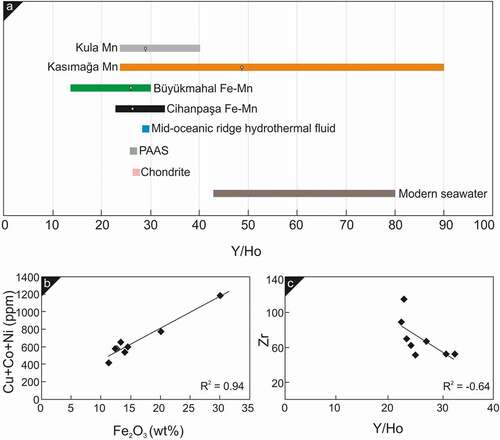
Table 2. REE indices of Jurassic chert assemblages (Franciscan Terrane, California) formed in different depositional environments (from Murray et al., 1991) and some Late Cretaceous radiolarian-chert-hosted Fe-Mn deposits in an ophiolitic melange complex belonging to the İzmir-Ankara-Erzincan ocean
Figure 9. Binary plot of Fe/Ti vs Al/(Al+Fe+Mn) showing distribution of radiolarian chert-hosted Fe- and Mn deposits from Turkey (based on Boström, Citation1970; Boström et al., Citation1976). The grey zone reflects ideal mixing curves between metalliferous and terrigenous sediments, and between metalliferous sediments and Pacific Ocean pelagic sediments. Percentages indicate magnitudes of end-member hydrothermal component on basis of data for East Pacific Rise metalliferous sediment
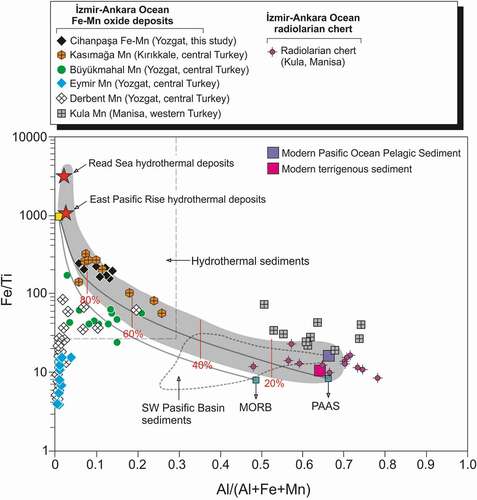
Figure 10. a LaSN/CeSN vs Al2O3/(Al2O3 + Fe2O3) diagram. b Plots of Fe2O3/TiO2 vs Al2O3/(Al2O3 + Fe2O3), c 100*Fe2O3/SiO2 vs 100*Al2O3/SiO2, d Fe2O3/100-SiO2 vs Al2O3/100-SiO2. Fields of ridge, pelagic, and continental margin are taken from Murray (Citation1994). e, f Diagrams of ratios of Ti/V and LuSN/LaSN (Murray, Citation1994)
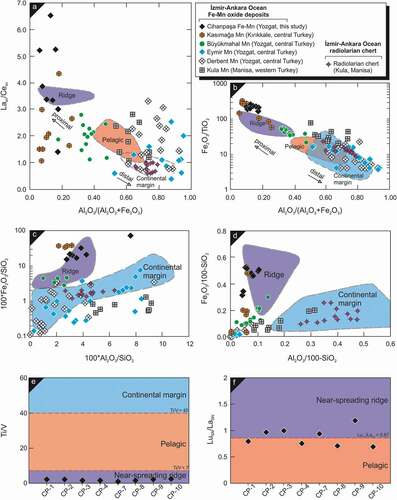
Figure 11. Comparison of ΣREE/Fe values of Late Cretaceous radiolarian chert-hosted Fe- and Mn-oxide deposits from Turkey and modern hydrothermal sediments from the East Pacific Rise (Ruhlin & Owen, Citation1986). All data of the radiolarian chert-hosted Fe-Mn oxide deposits from the mélange complexes belonging to the İzmir-Ankara-Erzincan Neotethyan ocean are for comparison. (Kasımağa, Kırıkkale, Koç et al., Citation2000; Büyükmahal, Yozgat, Öksüz & Okuyucu, Citation2014). Chemical analyses of radiolarian chert are from the Vezirler mélange (Kula, Manisa, western Turkey) (unpublished data, Aytaçegerler, Citation2020)
